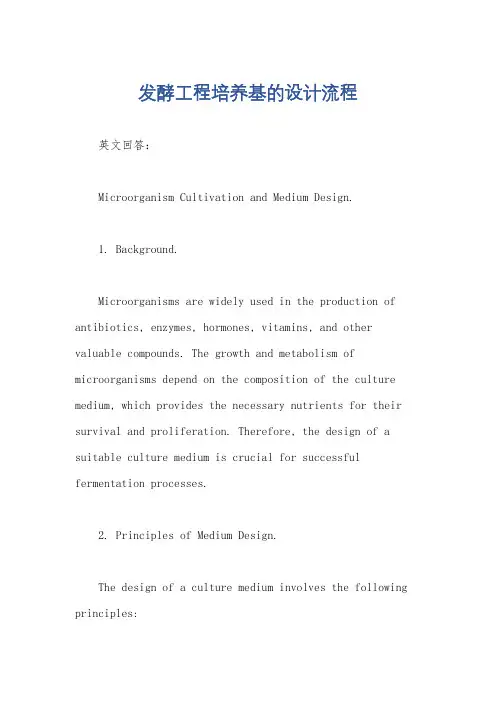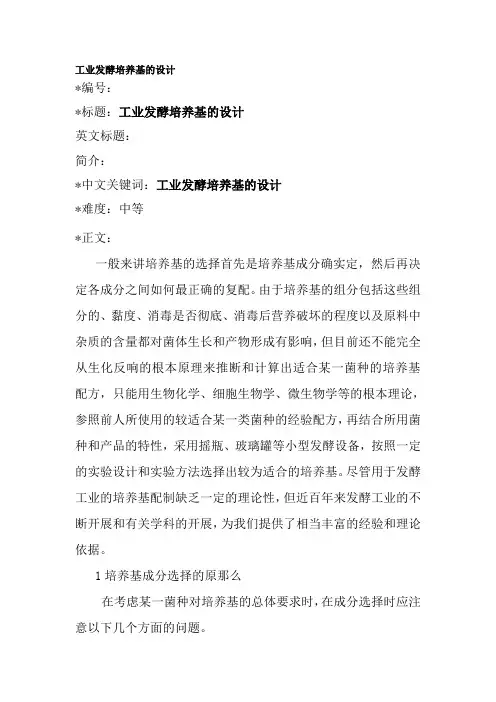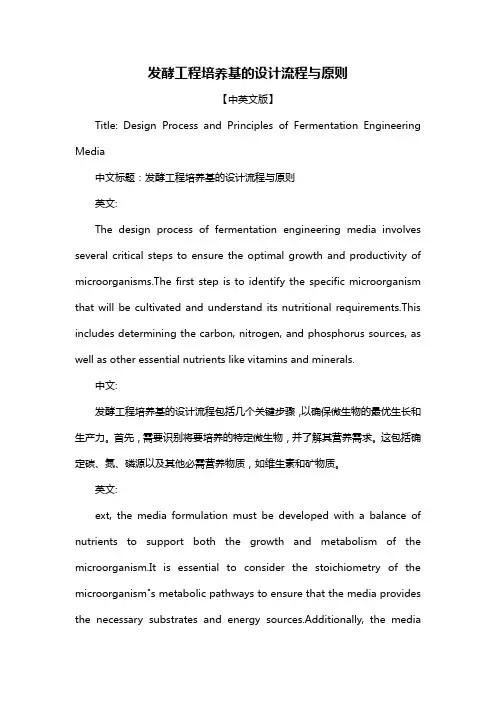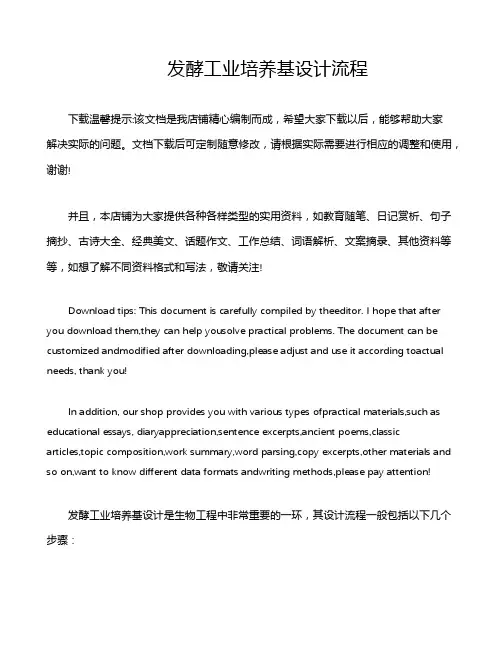发酵工业培养基设计
- 格式:ppt
- 大小:4.05 MB
- 文档页数:34



发酵工程培养基的设计流程英文回答:Microorganism Cultivation and Medium Design.1. Background.Microorganisms are widely used in the production of antibiotics, enzymes, hormones, vitamins, and other valuable compounds. The growth and metabolism of microorganisms depend on the composition of the culture medium, which provides the necessary nutrients for their survival and proliferation. Therefore, the design of a suitable culture medium is crucial for successful fermentation processes.2. Principles of Medium Design.The design of a culture medium involves the following principles:Nutritional requirements: The medium must contain all the essential nutrients required by the microorganism for growth, including carbon, nitrogen, phosphorus, sulfur, and vitamins.pH and temperature: The medium must maintain an optimal pH and temperature range for the growth of the microorganism.Oxygen requirements: Aerobic microorganisms require oxygen for growth, while anaerobic microorganisms require an oxygen-free environment.Sterility: The medium must be sterile to prevent contamination by other microorganisms.3. Types of Culture Media.There are two main types of culture media:Defined media: These media contain known quantities ofspecific nutrients, allowing for precise control of the composition.Complex media: These media contain a mixture of nutrients from natural sources, such as yeast extract or tryptone, and provide a rich source of growth factors.4. Medium Development Process.The development of a culture medium involves the following steps:Selection of carbon and nitrogen sources: The carbon source provides energy, while the nitrogen source provides amino acids and nucleic acids.Optimization of pH and temperature: The pH and temperature of the medium are adjusted to optimal values for microbial growth.Addition of trace elements and growth factors: Trace elements and growth factors are added to the medium tosupport specific metabolic pathways.Sterilization: The medium is sterilized by autoclaving or filtration to eliminate contaminating microorganisms.5. Applications of Microbial Cultivation.Microbial cultivation has numerous applications in biotechnology and industry, including:Production of pharmaceuticals: Antibiotics, vaccines, enzymes, and hormones are produced using microbial fermentation.Bioremediation: Microorganisms are used to degrade pollutants and clean up contaminated environments.Food production: Microorganisms are used in the production of fermented foods, such as bread, yogurt, and cheese.中文回答:发酵工程培养基设计。





工业发酵培养基的设计*编号:*标题:工业发酵培养基的设计英文标题:简介:*中文关键词:工业发酵培养基的设计*难度:中等*正文:一般来讲培养基的选择首先是培养基成分确实定,然后再决定各成分之间如何最正确的复配。
由于培养基的组分包括这些组分的、黏度、消毒是否彻底、消毒后营养破坏的程度以及原料中杂质的含量都对菌体生长和产物形成有影响,但目前还不能完全从生化反响的根本原理来推断和计算出适合某一菌种的培养基配方,只能用生物化学、细胞生物学、微生物学等的根本理论,参照前人所使用的较适合某一类菌种的经验配方,再结合所用菌种和产品的特性,采用摇瓶、玻璃罐等小型发酵设备,按照一定的实验设计和实验方法选择出较为适合的培养基。
尽管用于发酵工业的培养基配制缺乏一定的理论性,但近百年来发酵工业的不断开展和有关学科的开展,为我们提供了相当丰富的经验和理论依据。
1培养基成分选择的原那么在考虑某一菌种对培养基的总体要求时,在成分选择时应注意以下几个方面的问题。
1菌体的同化能力一般只有小分子能够通过细胞膜进入细胞体内进行代谢。
微生物能够利用复杂的大分子是由于微生物能够分泌各种各样的水解酶类,在体外将大分子水解为微生物能够直接利用的小分子物质。
由于微生物酶系是不一样的。
因此有些微生物由于水解酶系的缺乏只能够利用简单的物质,而有些微生物那么可以利用较为复杂的物质。
因而在考虑培养基成分选择的时候,必须充分考虑菌种的同化能力,从而保证所选用的培养基成分是微生物能够利用的。
这一点在碳源和氮源的选取时特别要注意。
许多碳源和氮源都是复杂的有机物大分子,如淀粉、黄豆饼粉等,用这类原料作为培养基,微生物必须要具备分泌胞外淀粉酶和蛋白酶的能力,但不是所有的微生物都具备这种能力的。
对于酵母,一般仅能利用2~3糖,最多为4糖,因此酿造行业用粮食原料制酒时,对于原材料必须经过一系列的处理,最终获得酵母能够利用的碳源。
如以为代表的制曲大曲中含有丰富的淀粉酶和糖化酶,可以将淀粉转化为糖酿酒工艺,国外以麦芽麦芽中含有丰富的淀粉水解酶类,可以将淀粉转化为麦芽糖制酒为代表的酿酒工艺,这些都是千百年来广阔劳动人民实践的结果。

发酵工程培养基的设计流程与原则【中英文版】Title: Design Process and Principles of Fermentation Engineering Media中文标题:发酵工程培养基的设计流程与原则英文:The design process of fermentation engineering media involves several critical steps to ensure the optimal growth and productivity of microorganisms.The first step is to identify the specific microorganism that will be cultivated and understand its nutritional requirements.This includes determining the carbon, nitrogen, and phosphorus sources, as well as other essential nutrients like vitamins and minerals.中文:发酵工程培养基的设计流程包括几个关键步骤,以确保微生物的最优生长和生产力。
首先,需要识别将要培养的特定微生物,并了解其营养需求。
这包括确定碳、氮、磷源以及其他必需营养物质,如维生素和矿物质。
英文:ext, the media formulation must be developed with a balance of nutrients to support both the growth and metabolism of the microorganism.It is essential to consider the stoichiometry of the microorganism"s metabolic pathways to ensure that the media provides the necessary substrates and energy sources.Additionally, the mediashould be designed to minimize the risk of contamination and optimize the recovery of the product.中文:接下来,必须开发出一种营养平衡的培养基,以支持微生物的生长和代谢。


发酵工业培养基设计流程下载温馨提示:该文档是我店铺精心编制而成,希望大家下载以后,能够帮助大家解决实际的问题。
文档下载后可定制随意修改,请根据实际需要进行相应的调整和使用,谢谢!并且,本店铺为大家提供各种各样类型的实用资料,如教育随笔、日记赏析、句子摘抄、古诗大全、经典美文、话题作文、工作总结、词语解析、文案摘录、其他资料等等,如想了解不同资料格式和写法,敬请关注!Download tips: This document is carefully compiled by theeditor. I hope that after you download them,they can help yousolve practical problems. The document can be customized andmodified after downloading,please adjust and use it according toactual needs, thank you!In addition, our shop provides you with various types ofpractical materials,such as educational essays, diaryappreciation,sentence excerpts,ancient poems,classicarticles,topic composition,work summary,word parsing,copy excerpts,other materials and so on,want to know different data formats andwriting methods,please pay attention!发酵工业培养基设计是生物工程中非常重要的一环,其设计流程一般包括以下几个步骤:1.明确目的:首先需要明确设计培养基的目的,是为了培养哪种微生物或生产哪种产物。